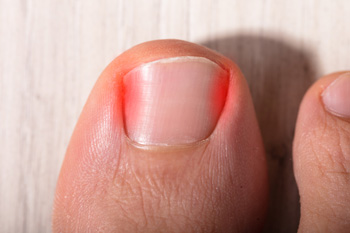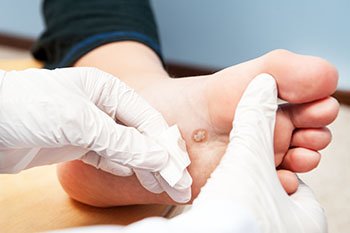
Hammertoe is a deformity where the toe becomes bent at the middle joint, causing pain, corns, and difficulty wearing shoes. It often results from muscle imbalance, wearing ill-fitting footwear, trauma, or genetic factors. Risk of developing a hammertoe increases with age, arthritis, and certain foot shapes. When conservative treatments no longer relieve discomfort, surgery may be necessary to realign the toe and restore function. Recovery time varies but often includes rest, limited activity, and wearing special footwear until healing is complete. A podiatrist evaluates the severity of the deformity, guides the surgical plan, and supports rehabilitation for optimal results. If you experience persistent pain or difficulty walking due to hammertoe, it is suggested that you consult a podiatrist to discuss your treatment options.
Foot surgery is sometimes necessary to treat a foot ailment. To learn more, contact Kent DiNucci, DPM of Ankle and Foot Clinic . Our doctor will assist you with all of your foot and ankle needs.
When Is Surgery Necessary?
Foot and ankle surgery is generally reserved for cases in which less invasive, conservative procedures have failed to alleviate the problem. Some of the cases in which surgery may be necessary include:
- Removing foot deformities like bunions and bone spurs
- Severe arthritis that has caused bone issues
- Cosmetic reconstruction
What Types of Surgery Are There?
The type of surgery you receive will depend on the nature of the problem you have. Some of the possible surgeries include:
- Bunionectomy for painful bunions
- Surgical fusion for realignment of bones
- Neuropathy decompression surgery to treat nerve damage
Benefits of Surgery
Although surgery is usually a last resort, it can provide more complete pain relief compared to non-surgical methods and may allow you to finally resume full activity.
Surgical techniques have also become increasingly sophisticated. Techniques like endoscopic surgery allow for smaller incisions and faster recovery times.
If you have any questions please feel free to contact our office located in Omaha, NE . We offer the newest diagnostic and treatment technologies for all your foot and ankle needs.

Ingrown toenails can be painful and persistent, but treatment options continue to evolve. Conservative care remains a first step for many. This includes warm salt soaks, gentle lifting of the nail edge, or protective padding to reduce pressure. Proper trimming techniques and footwear changes can also help prevent recurrence. When conservative measures do not bring relief, more advanced options may be considered. Newer treatments include partial nail removal combined with techniques to prevent regrowth along the problematic edge. This offers a long-term solution with minimal discomfort. In some cases, laser or chemical procedures are used to address the nail root directly. With both time-tested and modern approaches available, treatment can be tailored to fit each person’s needs and lifestyle. If you have recurring or painful ingrown toenails, it is suggested that you schedule an appointment with a podiatrist for a diagnosis and treatment deemed best for you.
Ingrown toenails can become painful if they are not treated properly. For more information about ingrown toenails, contact Kent DiNucci, DPM of Ankle and Foot Clinic . Our doctor can provide the care you need to keep you pain-free and on your feet.
Ingrown Toenails
Ingrown toenails occur when a toenail grows sideways into the bed of the nail, causing pain, swelling, and possibly infection.
Causes
- Bacterial infections
- Improper nail cutting such as cutting it too short or not straight across
- Trauma to the toe, such as stubbing, which causes the nail to grow back irregularly
- Ill-fitting shoes that bunch the toes too close together
- Genetic predisposition
Prevention
Because ingrown toenails are not something found outside of shoe-wearing cultures, going barefoot as often as possible will decrease the likeliness of developing ingrown toenails. Wearing proper fitting shoes and using proper cutting techniques will also help decrease your risk of developing ingrown toenails.
Treatment
Ingrown toenails are a very treatable foot condition. In minor cases, soaking the affected area in salt or antibacterial soaps will not only help with the ingrown nail itself, but also help prevent any infections from occurring. In more severe cases, surgery is an option. In either case, speaking to your podiatrist about this condition will help you get a better understanding of specific treatment options that are right for you.
If you have any questions please feel free to contact our office located in Omaha, NE . We offer the newest diagnostic and treatment technologies for all your foot and ankle needs.

Plantar warts are small growths that appear on the soles of the feet, often caused by the human papillomavirus, or HPV. They typically develop in areas of pressure, such as the heels or balls of the feet, where the virus enters through small cuts or cracks in the skin. Symptoms include a rough, grainy texture on the bottom of the foot, pain or tenderness when walking, and tiny black dots in the wart, which are blood vessels. The wart may grow larger or multiply over time, if left untreated. A podiatrist can diagnose plantar warts through a physical exam and may remove a small sample for testing, if needed. Treatment options include topical medication, cryotherapy, or minor surgical removal. In some cases, mild treatments may also help, but professional care ensures the most effective and thorough removal. If you have a painful plantar wart, it is suggested that you schedule an appointment with a podiatrist for a proper diagnosis and appropriate treatment plan.
Plantar warts can be very uncomfortable. If you need your feet checked, contact Kent DiNucci, DPM from Ankle and Foot Clinic . Our doctor will assist you with all of your foot and ankle needs.
About Plantar Warts
Plantar warts are the result of HPV, or human papillomavirus, getting into open wounds on the feet. They are mostly found on the heels or balls of the feet.
While plantar warts are generally harmless, those experiencing excessive pain or those suffering from diabetes or a compromised immune system require immediate medical care. Plantar warts are easily diagnosed, usually through scraping off a bit of rough skin or by getting a biopsy.
Symptoms
- Lesions on the bottom of your feet, usually rough and grainy
- Hard or thick callused spots
- Wart seeds, which are small clotted blood vessels that look like little black spots
- Pain, discomfort, or tenderness of your feet when walking or standing
Treatment
- Freezing
- Electric tool removal
- Laser Treatment
- Topical Creams (prescription only)
- Over-the-counter medications
To help prevent developing plantar warts, avoid walking barefoot over abrasive surfaces that can cause cuts or wounds for HPV to get into. Avoiding direct contact with other warts, as well as not picking or rubbing existing warts, can help prevent the further spread of plantar warts. However, if you think you have developed plantar warts, speak to your podiatrist. He or she can diagnose the warts on your feet and recommend the appropriate treatment options.
If you have any questions please feel free to contact our office located in Omaha, NE . We offer the newest diagnostic and treatment technologies for all your foot and ankle needs.

